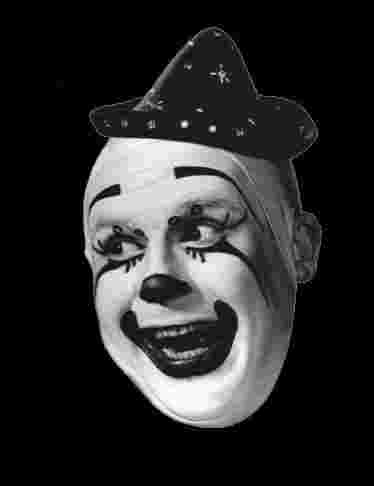|
|

Oct. 2, 1922 - Dec. 30, 1970
|
One of the nation's most recognizable circus clowns, he gained fame as "America's Picture Clown", a title given him by Ringling Bros. and Barnum & Bailey Circus publicist Roland Butler, referring to Dann's popularity with press photographers visiting the circus and their resulting numerous studies of him in his classic face makeup and clown wardrobe. His costumes were the envy of his peers; he owned over a hundred custom creations, all designed and hand-sewn by his seamstress mother, until her passing in 1954. His image graced the pages of at least two national magazines in the same year (National Geographic and Holiday). He was included on the cover of the 1951 Ideals Magazine circus issue, an international favorite among memorabilia collectors. He became one of the top four most photographed clowns of the era, sharing the spotlight with fellow funnymen Felix B. Adler, Emmett Kelly, and Lou Jacobs. The son of St. Louis Missouri banker William J. Dann and Beatrice Deems Dann, he decided after seeing his first tent show that he wanted to become a circus clown. In 1941, at the age of twenty, he became an apprentice "First Of May", (see Circus Lingo) member of clown alley with "The Greatest Show On Earth", Ringling Bros. and Barnum & Bailey circus, much to the protestations of his father, who had a career in banking in mind for his son. In the circus profession of generation-grounded participants, he was the only member of his family to perform under the big top, on America's largest tented circus, so large in fact it was nicknamed "Big Bertha" and traveled on two full railroad trains. In addition to his highly-photogenic "clean" whiteface makeup and extensive show wardrobe, he was a talented trombone player, which came in handy as he performed with a number of clown bands over the years. Dann was very proficient at training ducks, using a number of them in his clown acts, "Horatio" being his first such star. He also trained and worked with dogs, built props and created the snake in the basket clown routine, wherein a clown carrying a basket is surprised by a giant snake rising from the basket, kissing the clown on his nose, then disappearing back into the basket (a false arm holding the basket allowed the clown's free arm to operate the snake puppet). Another Harry Dann clown gag popular to this day is the mermaid, which he devised with fellow clown collaborator Bobby Kellogg during their Ringling years. This gag featured a sailor carrying a mermaid all the way around the track as the mermaid primps and preens in a seashell-encrusted mirror "she" holds. The mermaid was of course the clown with a false fishtail secured around his waist, and the sailor maniken's head and body walked by virtue of the mermaid/clown's own legs. On the Ringling show and in later years for other circuses he clowned with his peers Kellogg, The Sherman Bros. (Chester & Joe), Freddy Freeman, and Paul Jung. A graduate of University City High School in University City Missouri, he coached the circus children daily in their school work, and off-season at winter quarters served as high school teacher for them throughout his career. He left Ringling after eight years to clown with Louis Stern's smaller Polack Bros. circus, popular with performers for its more comfortable indoor Shrine-sponsored dates. Dann satyed on Polack as one of its star clowns through 1959, then alternating seasons on the tented Clyde Beatty-Cole Bros. Circus, and family-owned Cristiani Bros. Circus. In 1966 he signed with the under-canvas Carson and Barnes Circus owned by D.R. and Isla Miller. In his final seasons with Carson-Barnes he set aside his popular clown character, explaining "too many wrinkles" made his celebrated makeup "no longer possible" to wear properly. He instead performed in the capacity of sideshow talker and circus ringmaster until the end of the 1970 season, the same year of his death. In rapidly-declining health, on December 29, 1970, he was rushed by ambulance from Carson and Barnes winter quarters in Hugo, Oklahoma to De Paul Hospital in St. Louis Missouri (a ten to twelve hour drive), where he expired the following day. The world-renowned countenance for which he will be remembered - his trademark clown makeup - is considered by his peers, circus entrepreneurs, generations of circus fans and makeup artists alike to be one of the most universally acknowledged examples of traditional whiteface makeup ever designed and applied. Years after his passing, photos and renderings of him are still being used in circus press releases, and adorn circus posters and wagons throughout America, a tribute to his "Picture Clown" status, makeup artistry, and clowning abilities. |
|
| NEXT PERFORMER |
| Main Entrance | Circuses | Performers | Owners |
| Copyright © 2013 Circuses and Sideshows Dot Com |